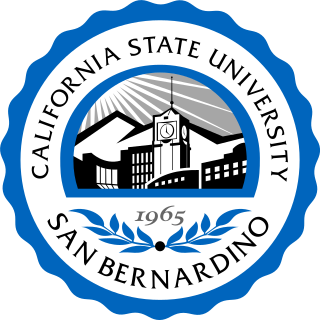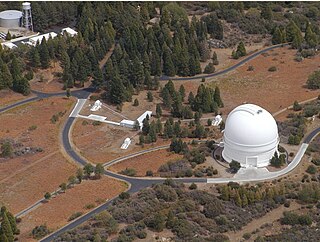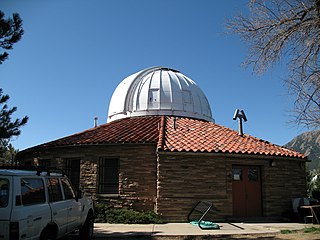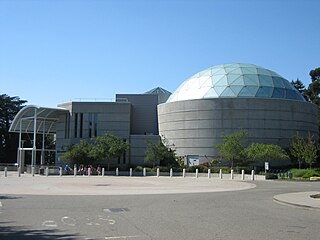
The California State University is a public university system in California. With 23 campuses and eight off-campus centers enrolling 485,550 students with 55,909 faculty and staff, CSU is the largest four-year public university system in the United States. It is one of three public higher education systems in the state, with the other two being the University of California system and the California Community Colleges. The CSU system is incorporated as The Trustees of the California State University. The CSU system headquarters is located in Long Beach, California.

Yerkes Observatory is an astronomical observatory located in Williams Bay, Wisconsin, United States. The observatory was operated by the University of Chicago Department of Astronomy and Astrophysics from its founding in 1897 to 2018. Ownership was transferred to the non-profit Yerkes Future Foundation (YFF) in May 2020, which began restoration and renovation of the historic building and grounds. Re-opening for public tours and programming began May 27, 2022.

The Lick Observatory is an astronomical observatory owned and operated by the University of California. It is on the summit of Mount Hamilton, in the Diablo Range just east of San Jose, California, United States. The observatory is managed by the University of California Observatories, with headquarters on the University of California, Santa Cruz campus, where its scientific staff moved in the mid-1960s. It is named after James Lick.

The Mount Wilson Observatory (MWO) is an astronomical observatory in Los Angeles County, California, United States. The MWO is located on Mount Wilson, a 1,740-meter (5,710-foot) peak in the San Gabriel Mountains near Pasadena, northeast of Los Angeles.

California State University, San Bernardino is a public research university in San Bernardino, California. Founded in 1965, it is one of the 23 general campuses of the California State University system. The main campus sits on 441 acres (178 ha) in the University District of San Bernardino, with a branch campus of 40 acres (16 ha) in Palm Desert, California, opened in 1986. Cal State San Bernardino's fall 2020 enrollment was 19,404. In fall 2018, it had 310 full-time faculty, of which 220 were on the tenure track.

A refracting telescope is a type of optical telescope that uses a lens as its objective to form an image. The refracting telescope design was originally used in spyglasses and astronomical telescopes but is also used for long-focus camera lenses. Although large refracting telescopes were very popular in the second half of the 19th century, for most research purposes, the refracting telescope has been superseded by the reflecting telescope, which allows larger apertures. A refractor's magnification is calculated by dividing the focal length of the objective lens by that of the eyepiece.

Palomar Observatory is an astronomical research observatory in San Diego County, California, United States, in the Palomar Mountain Range. It is owned and operated by the California Institute of Technology (Caltech). Research time at the observatory is granted to Caltech and its research partners, which include the Jet Propulsion Laboratory (JPL), Yale University, and the National Optical Observatories of China.

Palomar Mountain is a mountain ridge in the Peninsular Ranges in northern San Diego County. It is famous as the location of the Palomar Observatory and Hale Telescope, and known for the Palomar Mountain State Park.

Mount Wilson is a peak in the San Gabriel Mountains, located within the San Gabriel Mountains National Monument and Angeles National Forest in Los Angeles County, California. With only minor topographical prominence the peak is not naturally noticeable from a distance, although it is easily identifiable due to the large number of antennas near its summit. It is a subsidiary peak of nearby San Gabriel Peak.

South African Astronomical Observatory (SAAO) is the national centre for optical and infrared astronomy in South Africa. It was established in 1972. The observatory is run by the National Research Foundation of South Africa. The facility's function is to conduct research in astronomy and astrophysics. The primary telescopes are located in Sutherland, which is 370 kilometres (230 mi) from Observatory, Cape Town, where the headquarters is located.
Leuschner Observatory, originally called the Students' Observatory, is an observatory jointly operated by the University of California, Berkeley and San Francisco State University. The observatory was built in 1886 on the Berkeley campus. For many years, it was directed by Armin Otto Leuschner, for whom the observatory was renamed in 1951. In 1965, it was relocated to its present home in Lafayette, California, approximately 10 miles (16 km) east of the Berkeley campus. In 2012, the physics and astronomy department of San Francisco State University became a partner.

Mount Laguna Observatory (MLO) is an astronomical observatory owned and operated by San Diego State University (SDSU). The telescope was operated in partnership with the University of Illinois at Urbana-Champaign (UIUC) until 2000. MLO is located approximately 75 kilometers (47 mi) east of downtown San Diego, California (USA) on the eastern edge of the Cleveland National Forest in the Laguna Mountains on the SDSU Astronomy Campus near the hamlet of Mount Laguna. MLO was dedicated on June 19, 1968, seven years after SDSU's Department of Astronomy became an independent academic department of SDSU's College of Sciences. The dedication took place during the 1968 summer meeting of the Astronomical Society of the Pacific. Currently SDSU is working with University of Kansas (KU), and UNC Chapel Hill on various projects.

Sommers–Bausch Observatory is an astronomical observatory located on and owned by University of Colorado Boulder. The building was initially completed in 1953 and named after Elmer E. Sommers and Carl L. Bausch.

Big Bear Solar Observatory (BBSO) is a university-based solar observatory in the United States. It is operated by New Jersey Institute of Technology (NJIT). BBSO has a 1.6-meter (5.2 ft) clear aperture Goode Solar Telescope (GST), which has no obscuration in the optical train. BBSO is located on the north side of Big Bear Lake in the San Bernardino Mountains of southwestern San Bernardino County, California, U.S., approximately 120 kilometers (75 mi) east of downtown Los Angeles. The telescopes and instruments at the observatory are designed and employed specifically for studying the activities and phenomena of the Sun.

Fremont Peak Observatory (FPOA) is an astronomical observatory operated by Fremont Peak Observatory Association and operated by Fremont Peak Observatory Association (FPOA) under contract to the State of California. Built in 1986, it is located in Fremont Peak State Park, near San Juan Bautista, California. Fremont Peak Observatory houses the Challenger telescope.

Van Vleck Observatory is an astronomical observatory owned and operated by Wesleyan University. It was built in 1914 and named after the former head of the Department of Mathematics and Astronomy at the university, Prof. John M. Van Vleck. It is located in Middletown, Connecticut (USA).

Chabot Space and Science Center, located in Oakland, California, is a center for science learning featuring interactive exhibits, planetariums, a large screen theater, hands-on activities and three powerful telescopes.

The University of Illinois Astronomical Observatory, located at 901 S. Mathews Avenue in Urbana, Illinois, on the campus of the University of Illinois Urbana-Champaign, was built in 1896, and was designed by Charles A. Gunn. It has been listed on the National Register of Historic Places since November 6, 1986, and on December 20, 1989, was designated a National Historic Landmark.
The California State University, San Bernardino College of Natural Sciences is the San Bernardino region's largest center for science education and research. With nine departments and various specialties, it has many accredited programs, including bachelor's and master's degree programs, and curricula for pre-professional students in medicine, veterinary medicine and dentistry. It provides scientific literacy for all California State University, San Bernardino graduates, and participates in the training of future mathematics and science teachers.

The Class of 1951 Observatory is located near the eastern edge of the town of Poughkeepsie, New York, on Vassar College's campus.



















